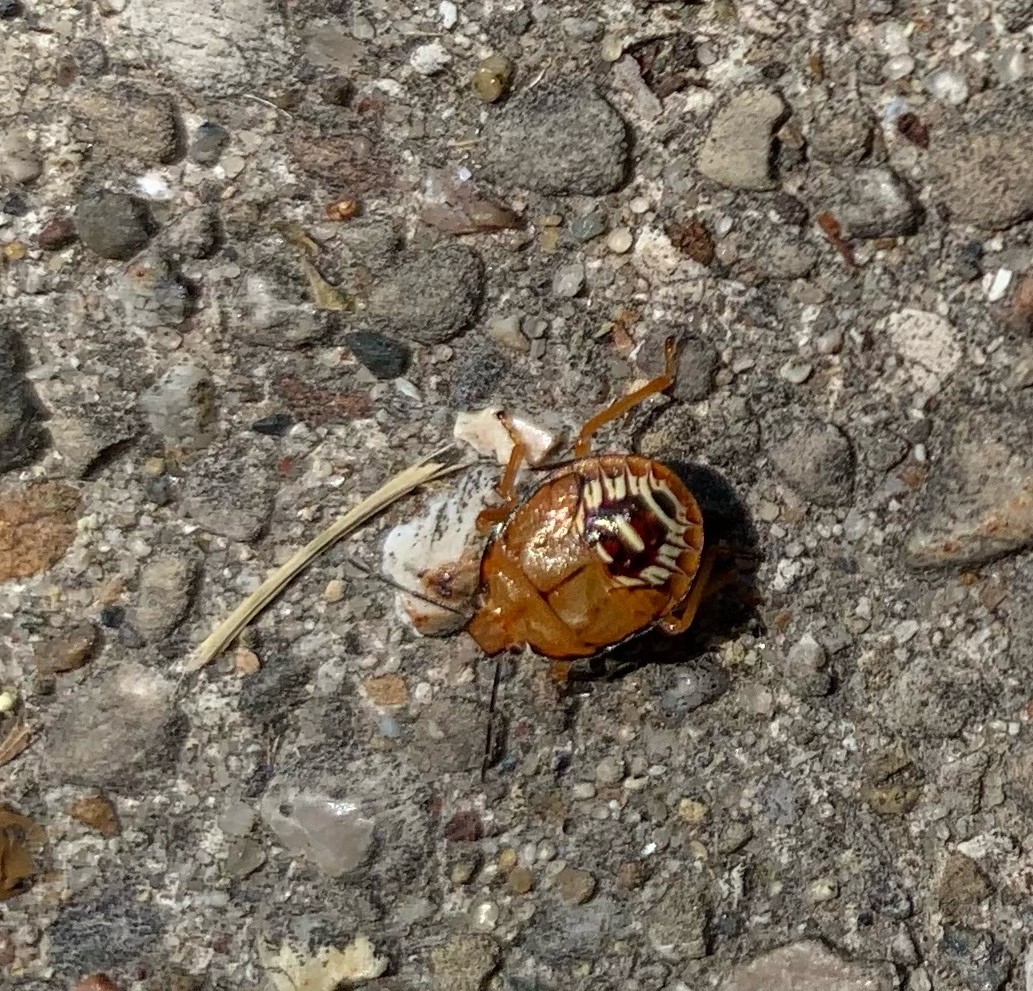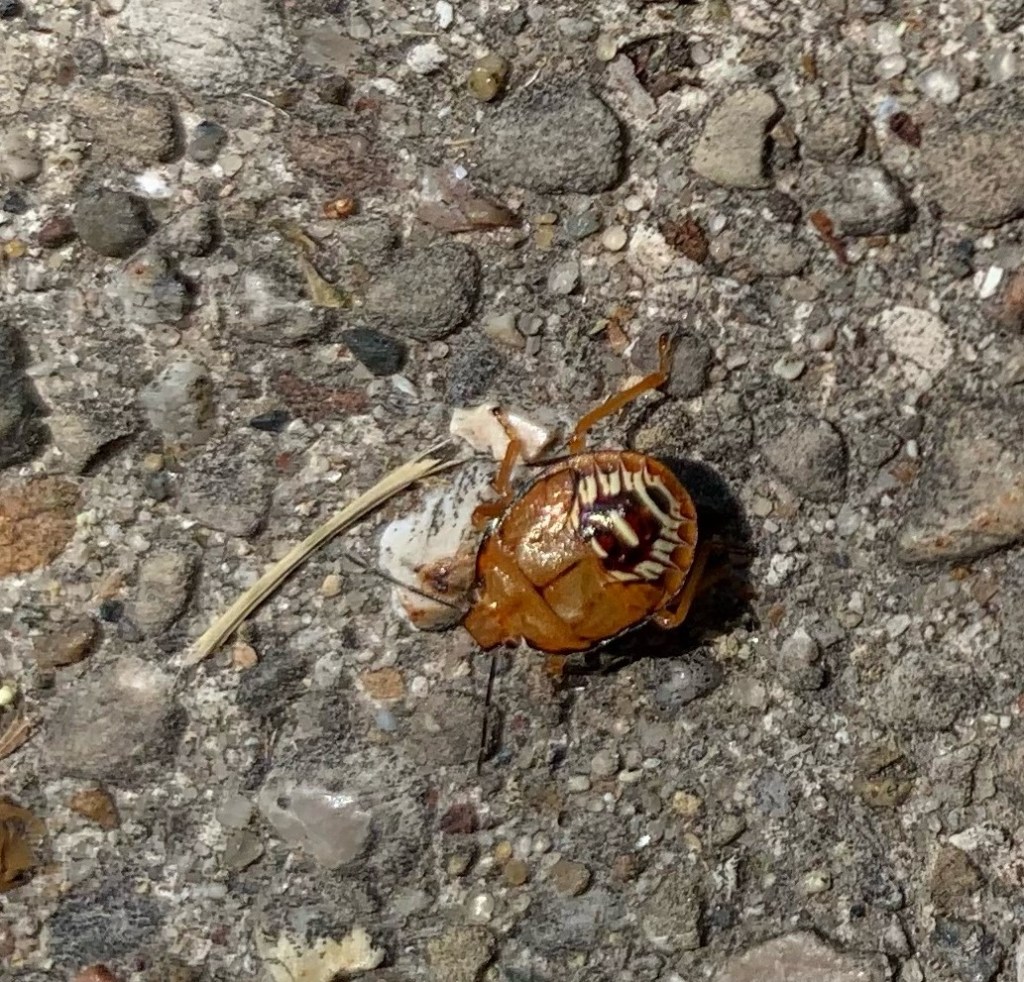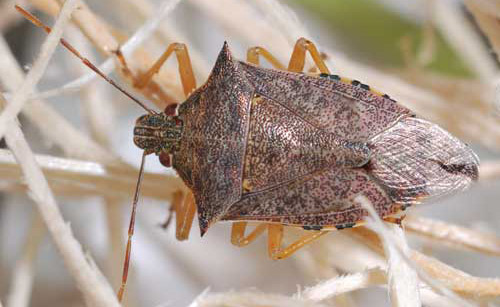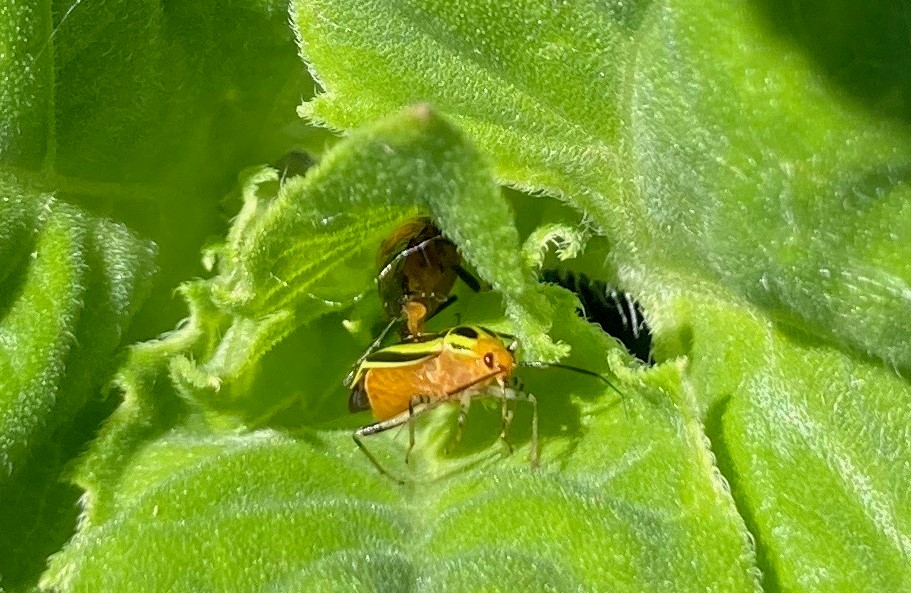Warning: this post may not be suitable for readers who are upset by insects eating other insects.
As I wrote recently, our friend Jo ana came over to help with the garden last week. She is a keen observer of the natural world. This applies to insects as well as flying Geranium seeds. So we were inspecting some of the plants when we saw something that looked like a tick. Instead of squishing it, we tried to get a better look and as a result the critter ended up on the sidewalk.
So it turned out that it was not a tick but a Spined Soldier Bug. Not an adult, but the third instar of the nymph. Spined Soldier Bugs are predators that eat many insect pests in the garden. And aren’t those interesting markings on its back?
An adult Spined Soldier Bug looks like this.
Upon realizing that there were Spined Soldier Bugs in the garden, my reaction was: what took you so long? Because for a couple of years I have been grinding my teeth while enduring the damage done by Four-Lined Plant Bugs (FLPBs). The FLPBs have decimated my Anise Hyssop (Agastache foeniculum) and Culver’s Root (Veronicastrum virginicum), while inflicting less serious damage on various other plants.
Nevertheless, I have stood by my commitment to keep all insecticides out of our garden. I would squish the occasional FLPB when I could grab one, and clear out the affected plants in the fall. To be honest, these steps were not very effective. But I would rather live with the plant damage than contribute to the decline of bees and other pollinators by using pesticides. And actually, the FLPB is the only pest in the garden that causes serious damage.
So we very carefully got that Spined Soldier Bug onto a leaf and deposited him/her onto a plant afflicted with FLPBs.
The very next day I was inspecting an annual Sunflower plant when I observed a Spined Soldier Bug! And he was eating an FLPB! In case you’re wondering, Spined Soldier Bugs attack their prey with sharp beaks that stay hidden under their abdomens until the moment of truth.
So I was very glad we hadn’t squished that Spined Soldier Bug under the mistaken impression that it was a tick. Of course, there are already lots of insect predators in the garden. But I’m hoping that the Spined Soldier Bug population, combined with other predators, grows to the point where they can minimize the damage from the FLPBs.
For those of you who are not fans of insect mayhem, the next post will have lots of pretty flowers, I promise.










Bugs eating bugs is one of my favorite aspects of gardening. When I grew tomatoes, I was always excited to find hornworms parasitized by braconid wasps. That spined soldier bug resembles a stink bug. If I think I see the latter, I will have to inspect it further to see if is is the former. As always, an informative post!
Actually, it appears this soldier bug is a kind of stink bug, but a beneficial one.
Fascinating! The soldier bug looks so much like a stink bug. I will continue to throw stink bugs outside just in case they are Spined Soldier Bugs who might do great things in my garden.
So it actually is a beneficial kind of stinkbug. https://askentomologists.com/2015/08/30/stink-bugs-telling-the-good-ones-from-the-bad-ones/
Oh, thanks!!!
Congrats for holding on to your commitment to keep your garden pesticide free – kudos! It takes a while to let nature come back into balance, but it can be done and you’ve proved it. 🙂
Now if I can just convince all my neighbors.
Yes!
Great to see the Spined Solider bug in action. I’ve never seen one eating another, but we do get bugs that have the same shape as yours (the ones we have are also called Stink Bugs). We are also relying on the bugs to keep the pests away.
The Soldier Bugs are a kind of stink bug – see this link. https://askentomologists.com/2015/08/30/stink-bugs-telling-the-good-ones-from-the-bad-ones/
Thanks for that link, I didn’t know anything about these bugs although they have always been around, I’ll pay attention now!
What an impressive creature. I could do with some for my lily beetles. What an impressive weapon to keep in your abdomen. I have to make do with my finger nails. It’s a disgusting business caring for lilies in my garden.
I do not mind squishing the FLPB by hand but they are fairly small. I have yet to come face-to-face with the lily bug, thank goodness.
Nature – it is what it is. 🙂
For better and worse.
This is a really interesting post. I am familiar with the adult spined soldier bug but not as a teenager. We were brought up with information on the benefits of ladybirds and preying mantis but not really the wider world of entomology.
Which is too bad, right? Kids should be trained not to be repulsed by insects, and I think most have a natural curiosity about them that should be cultivated.
Nice title–good take-off on a famous hymn. Intriguing post. Life’s tough in the natural world.
I’m glad you caught the reference – wondered if anyone would. I thought of spelling it “spin-ed” in the title to be more suggestive of the meter of the lyrics.
It is good to know you do not use insecticides and that this little soldier was able to do his job! Nature is cruel, but clever.
Cruel but effective.
I am trying to learn to ID the Spined Soldier Bug from the pest stink bugs. They are capable of making a slurpy out of many pests. It seems the SSB has “shoulders” that resemble the ladies’ fad shoulder pads of the 80’s and show that dark stripe on their membraneous wings. We can’t be too observant. Thanks for the heads up.
Check out this post: https://askentomologists.com/2015/08/30/stink-bugs-telling-the-good-ones-from-the-bad-ones/
I had no idea about this remarkable killer bug (assasin for the good side ? LOL) .. When we are in a rush to rid ourselves of what we think are bad bugs .. this discovery comes too late most times .. but now you have inspired me to be a little more careful about getting rid of what I may think are bad boy bugs ? LOL
Sadly I see lady bugs less and less each year .. but I have seen lots of very large, fluffy, honey bees enjoying the garden and that makes me smile.
The bumble bees make me smile as well. Actually they look too fat to fly, like little teddy bears. But who am I to talk?
Thank you for the informative post!
You’re welcome!
We have got something very similar in the garden but I had not idea it might feast on the baddies. Next time I see it I will try and check out if we have the European equivalent. Amelia
According to this fact sheet this insect is native to North America but has been introduced in other parts of the world for pest control. https://entnemdept.ufl.edu/creatures/beneficial/podisus_maculiventris.htm
Thanks for that!
I learned about two bugs I am not familiar with. I hope to never get to know FLPBs. I will be looking at all the Soldier bugs to see if they have spines.
Try using this link. https://askentomologists.com/2015/08/30/stink-bugs-telling-the-good-ones-from-the-bad-ones/
Everything gets eaten! I’ve never heard of this one.
And everybody.
Cool!
Yes!
Organic gardening takes a bit of patience but you held your nerve and here’s the reward! I had similar experiences with aphids and ladybugs which are now here in good numbers. Do the birds also eat those FLPBs?
I’m really not sure. I certainly hope so.
I know it’s better for everyone in the end, but it does take some re-adjustment and changing of mind set to allow hostas to become lacy, blackfly to swarm plants, birds to pick virtually every berry in the garden and allow a full eco-system to develop with plants at the bottom of large food web. A rich and diverse garden that supports this will not look Chelsea Flower Show-perfect, but then that’s not the objective, is it?
Exactly.
Yay for that soldier bug! Glad you didn’t squish it. And maybe where there is one, there are more.
That’s what I’m hoping.
Fascinating creature. It looks a little like our shield bugs. I won’t use chemicals either.xxx
I would expect nothing less.
I sure enough would have thought this was a shield bug, or one of those stink bugs. We have something called a soldier beetle down here that looks quite different — probably because it’s a beetle rather than a bug. It seems to enjoy flowers, and often shows up on Gaillardia and such.
My favorite bug-eats-bug story involves two damselflies. I was at work, and noticed them on the boat’s handrail. I thought they were mating, but not so much. One was eating the other, as daintily as you please. Here’s the kicker: the one having dinner consumed every bit of the other insect except for the eyes. When I realized what they were, I brought them home and photographed them. I didn’t have a macro lens at that point, but it worked out well enough!
Now that is a gruesome but fascinating tale and image!
Given all the mayhem our species causes, a little insect mayhem seems acceptable.
Insect mayhem is purely and always for survival, more than you can say for people.
Exactly so.